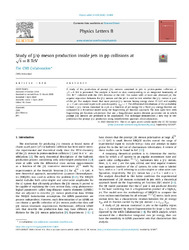Study of J/ψ meson production inside jets in pp collisions at √s=8 TeV
| dc.contributor.author | Sirunyan, A. M. | |
| dc.contributor.author | Işıldak, Bora | |
| dc.date.accessioned | 2024-03-12T06:56:58Z | |
| dc.date.available | 2024-03-12T06:56:58Z | |
| dc.date.issued | 2020-05-10 | |
| dc.identifier.issn | 0370-2693 | en_US |
| dc.identifier.uri | http://hdl.handle.net/10679/9293 | |
| dc.identifier.uri | https://www.sciencedirect.com/science/article/pii/S0370269320302136 | |
| dc.description.abstract | A study of the production of prompt J/ψ mesons contained in jets in proton-proton collisions at s=8TeV is presented. The analysis is based on data corresponding to an integrated luminosity of 19.1 fb−1 collected with the CMS detector at the LHC. For events with at least one observed jet, the angular separation between the J/ψ meson and the jet is used to test whether the J/ψ meson is part of the jet. The analysis shows that most prompt J/ψ mesons having energy above 15 GeV and rapidity |y|<1 are contained in jets with pseudorapidity |ηjet|<1. The differential distributions of the probability to have a J/ψ meson contained in a jet as a function of jet energy for a fixed J/ψ energy fraction are compared to a theoretical model using the fragmenting jet function approach. The data agree best with fragmenting jet function calculations that use a long-distance matrix element parameter set in which prompt J/ψ mesons are predicted to be unpolarized. This technique demonstrates a new way to test predictions for prompt J/ψ production using nonrelativistic quantum chromodynamics. | en_US |
| dc.description.sponsorship | BMBWF and FWF (Austria); FNRS and FWO (Belgium); CNPq, CAPES, FAPERJ, FAPERGS, and FAPESP (Brazil); MES (Bulgaria); CERN; CAS, MOST, and NSFC (China); COLCIENCIAS (Colombia); MSES and CSF (Croatia); RPF (Cyprus); SENESCYT (Ecuador); MoER, ERC IUT, and ERDF (Estonia); Academy of Finland, MEC, and HIP (Finland); CEA and CNRS/IN2P3 (France); BMBF, DFG, and HGF (Germany); GSRT (Greece); NKFIA (Hungary); DAE and DST (India); IPM (Iran); SFI (Ireland); INFN (Italy); MSIP and NRF (Republic of Korea); MES (Latvia); LAS (Lithuania); MOE and UM (Malaysia); BUAP, CINVESTAV, CONACYT, LNS, SEP, and UASLP-FAI (Mexico); MOS (Montenegro); MBIE (New Zealand); PAEC (Pakistan); MSHE and NSC (Poland); FCT (Portugal); JINR (Dubna); MON, ROSATOM, RAS, RFBR, and NRC KI (Russia); MESTD (Serbia); SEIDI, CPAN, PCTI, and FEDER (Spain); MoSTR(Sri Lanka); Swiss Funding Agencies (Switzerland); MST (Taipei); ThEPCenter, IPST, STAR, and NSTDA (Thailand); TUBITAK and TAEK (Turkey); NASU and SFFR (Ukraine); STFC (United Kingdom); DOE and NSF (USA). Individuals have received support from the Marie-Curie program and the European Research Council and Horizon 2020 Grant, contract No. 675440 (European Union); the Leventis Foundation; the Alfred P. Sloan Foundation; the Alexander von Humboldt Foundation; the Belgian Federal Science Policy Office; the Fonds pour la Formation a la Recherche dans l'Industrie et dans l'Agriculture (FRIA-Belgium); the Agentschap voor Innovatie door Wetenschap en Technologie (IWT-Belgium); the F.R.S. -FNRSand FWO (Belgium) under the "Excellence of Science -EOS" -be.h project n. r 30820817; The Ministry of Education, Youth and Sports(MEYS) of the Czech Republic; the Lendulet ("Momentum") Program and the Janos Bolyai Research Scholarship of the Hungarian Academy of Sciences, the New National Excellence Program UNKP, the NKFIA research grants 123842, 123959, 124845, 124850, and 125105 (Hungary); the Council of Science and Industrial Research, India; the HOMING PLUS program of the Foundation for Polish Science, cofinanced from European Union, Regional Development Fund, the Mobility Plus program of the Ministry of Science and Higher Education, the National Science Center (Poland), contracts Harmonia 2014/14/M/ST2/00428, Opus 2014/13/B/ST2/02543, 2014/15/B/ST2/03998, and 2015/19/B/ST2/02861, Sonata-bis 2012/07/E/ST2/01406; the National Priorities Research Program by Qatar National Research Fund; the Programa Estatal de Fomento de la Investigacion Cientifica y Tecnica de Excelencia Maria de Maeztu, grant MDM-2015-0509 and the Programa Severo Ochoa del Principado de Asturias; the Thalis and Aristeia programs cofinanced by EU-ESF and the Greek NSRF; the Rachadapisek Sompot Fund for Postdoctoral Fellowship, Chulalongkorn University and the Chulalongkorn Academic into Its 2nd Century Project Advancement Project (Thailand); The Welch Foundation, contract C-1845; and the Weston Havens Foundation (USA). | |
| dc.language.iso | eng | en_US |
| dc.publisher | Elsevier | en_US |
| dc.relation.ispartof | Physics Letters B | |
| dc.rights | openAccess | |
| dc.rights | Attribution 4.0 International | |
| dc.rights.uri | https://creativecommons.org/licenses/by/4.0/ | |
| dc.title | Study of J/ψ meson production inside jets in pp collisions at √s=8 TeV | en_US |
| dc.type | Article | en_US |
| dc.description.version | Publisher version | en_US |
| dc.peerreviewed | yes | en_US |
| dc.publicationstatus | Published | en_US |
| dc.contributor.department | Özyeğin University | |
| dc.contributor.authorID | (ORCID 0000-0002-0283-5234 & YÖK ID 124605) Işıldak, Bora | |
| dc.contributor.ozuauthor | Işıldak, Bora | |
| dc.creator | The CMS Collaboration | |
| dc.identifier.volume | 804 | en_US |
| dc.identifier.wos | WOS:000613068800001 | |
| dc.identifier.doi | https://doi.org/10.1016/j.physletb.2020.135409 | en_US |
| dc.subject.keywords | CMS | en_US |
| dc.subject.keywords | J/psi Mesons | en_US |
| dc.subject.keywords | Jets | en_US |
| dc.identifier.scopus | SCOPUS:2-s2.0-85082850250 | |
| dc.relation.publicationcategory | Article - International Refereed Journal - Institutional Academic Staff |
Files in this item
This item appears in the following Collection(s)
Share this page




